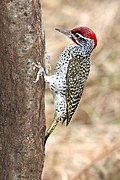Superregnum: Eukaryota
Regnum: Animalia
Subregnum: Eumetazoa
Cladus: Bilateria
Cladus: Nephrozoa
Superphylum: Deuterostomia
Phylum: Chordata
Cladus: Craniata
Subphylum: Vertebrata
Infraphylum: Gnathostomata
Superclassis: Tetrapoda
Cladus: Reptiliomorpha
Cladus: Amniota
Classis: Reptilia
Cladus: Eureptilia
Cladus: Romeriida
Subclassis: Diapsida
Cladus: Sauria
Infraclassis: Archosauromorpha
Cladus: Crurotarsi
Divisio: Archosauria
Subsectio: Ornithodira
Subtaxon: Dinosauromorpha
Cladus: Dinosauria
Ordo: Saurischia
Cladus: Theropoda
Cladus: Neotheropoda
Infraclassis: Aves
Cladus: Euavialae
Cladus: Avebrevicauda
Cladus: Pygostylia
Cladus: Ornithothoraces
Cladus: Euornithes
Cladus: Ornithuromorpha
Cladus: Ornithurae
Cladus: Carinatae
Parvclassis: Neornithes
Cohors: Neognathae
Ordo: Piciformes
Familia: Picidae
Subfamilia: Picinae
Genus: Campethera
Species: C. abingoni - C. bennettii - C. cailliautii - C. caroli - C. maculosa - C. mombassica - C. nivosa - C. notata - C. nubica - C. punctuligera - C. scriptoricauda - C. tullbergi
Name
Campethera G.R. Gray, 1841
References
A list of the genera of birds Ed.2 p. 70
Campethera is a genus of bird in the family Picidae, or woodpeckers, that are native to sub-Saharan Africa. Most species are native to woodland and savanna rather than deep forest, and multiple species exhibit either arboreal or terrestrial foraging strategies.[1] Its nearest relative is the monotypic genus Geocolaptes[1] of southern Africa, which employs terrestrial foraging and breeding strategies. They are however not close relatives of similar-looking woodpeckers in the "Dendropicos clade".
Taxonomy
The genus Campethera was introduced by the English zoologist George Robert Gray in 1841 with the little green woodpecker (Campethera maculosa) as the type species.[2] The generic name combines the Ancient Greek kampē meaning "caterpillar" and -thēras meaning "hunter".[3]
Species diversity in the "Campethera clade" is believed to be understated, and up to 18 species may be involved.[1] The following 11 species are currently recognized:[4]
| Image | Common Name | Scientific name | Distribution |
|---|---|---|---|
 |
Fine-spotted woodpecker | Campethera punctuligera | Benin, Burkina Faso, Cameroon, Central African Republic, Chad, Democratic Republic of the Congo, Gambia; Ghana, Guinea, Guinea-Bissau, Ivory Coast, Mali, Mauritania, Niger, Nigeria, Senegal, Sierra Leone, South Sudan, Sudan and Togo |
 |
Bennett's woodpecker | Campethera bennettii | Angola, Botswana, Burundi, Democratic Republic of the Congo, Malawi, Mozambique, Namibia, Rwanda, South Africa, Swaziland, Tanzania, Zambia, and Zimbabwe |
| Speckle-throated woodpecker | Campethera scriptoricauda | Mozambique, Malawi, and Tanzania | |
 |
Nubian woodpecker | Campethera nubica | from Chad in west to Somalia in east and Tanzania in south |
 South Africa, crop.jpg" decoding="async" srcset="//upload.wikimedia.org/wikipedia/commons/thumb/6/65/Golden-tailed_Woodpecker_-_MALE%2C_Campethera_abingoni%2C_at_Borakalalo_National_Park%2C_Northwest_Province%2C_South_Africa%2C_crop.jpg/180px-Golden-tailed_Woodpecker_-_MALE%2C_Campethera_abingoni%2C_at_Borakalalo_National_Park%2C_Northwest_Province%2C_South_Africa%2C_crop.jpg 1.5x, //upload.wikimedia.org/wikipedia/commons/thumb/6/65/Golden-tailed_Woodpecker_-_MALE%2C_Campethera_abingoni%2C_at_Borakalalo_National_Park%2C_Northwest_Province%2C_South_Africa%2C_crop.jpg/240px-Golden-tailed_Woodpecker_-_MALE%2C_Campethera_abingoni%2C_at_Borakalalo_National_Park%2C_Northwest_Province%2C_South_Africa%2C_crop.jpg 2x" data-file-width="744" data-file-height="790" height="127" width="120" /> South Africa, crop.jpg" decoding="async" srcset="//upload.wikimedia.org/wikipedia/commons/thumb/6/65/Golden-tailed_Woodpecker_-_MALE%2C_Campethera_abingoni%2C_at_Borakalalo_National_Park%2C_Northwest_Province%2C_South_Africa%2C_crop.jpg/180px-Golden-tailed_Woodpecker_-_MALE%2C_Campethera_abingoni%2C_at_Borakalalo_National_Park%2C_Northwest_Province%2C_South_Africa%2C_crop.jpg 1.5x, //upload.wikimedia.org/wikipedia/commons/thumb/6/65/Golden-tailed_Woodpecker_-_MALE%2C_Campethera_abingoni%2C_at_Borakalalo_National_Park%2C_Northwest_Province%2C_South_Africa%2C_crop.jpg/240px-Golden-tailed_Woodpecker_-_MALE%2C_Campethera_abingoni%2C_at_Borakalalo_National_Park%2C_Northwest_Province%2C_South_Africa%2C_crop.jpg 2x" data-file-width="744" data-file-height="790" height="127" width="120" /> |
Golden-tailed woodpecker | Campethera abingoni | Angola, Benin, Botswana, Cameroon, Central African Republic, Chad, Republic of the Congo, Democratic Republic of the Congo, Ivory Coast, Gambia, Ghana, Guinea, Guinea-Bissau, Kenya, Malawi, Mali, Mauritania, Mozambique, Namibia, Rwanda, Senegal, South Africa, South Sudan, Swaziland, Tanzania, Uganda, Zambia, and Zimbabwe |
 |
Mombasa woodpecker | Campethera mombassica | Kenya, Somalia, and Tanzania |
| Knysna woodpecker | Campethera notata | South Africa | |
 |
Green-backed woodpecker | Campethera cailliautii | Angola, Burundi, Cameroon, Central African Republic, Republic of the Congo, the Democratic Republic of the Congo, Equatorial Guinea, Ethiopia, Gabon, Ghana, Kenya, Malawi, Mozambique, Nigeria, Rwanda, Somalia, Sudan, Tanzania, Togo, Uganda, Zambia, and Zimbabwe |
| Little green woodpecker | Campethera maculosa | Senegal, Guinea-Bissau, Guinea, Sierra Leone, Liberia, Ivory Coast and Ghana | |
| Tullberg's woodpecker | Campethera tullbergi | western Cameroon, adjacent Nigeria and Bioko island | |
 |
Fine-banded woodpecker | Campethera taeniolaema | eastern Congo to Kenya and Tanzania |
Description
They are small to medium-sized woodpeckers.[5] The sexes are fairly similar, but males of most species have the crown and nape bright red, while in females this is restricted to the nape. Colour of the malar plumage is also useful in sexing.
Their plumage pattern is fairly uniform, and some species are only distinguishable by careful observation.[5] The mantle, back and wings are olive-greenish, and usually spotted or barred in buffy to golden yellow. The shafts of the remiges and rectrices are yellow to golden yellow.[5] The underpart plumage is spotted black to a lesser or greater degree.
Some species include drumming on dead wood as a means of non-vocal signaling. Most species are poor drummers however, and some species may not drum at all.[5]
Foraging
Their rectrices are only partially stiffened (for arboreal support), and they readily take to terrestrial foraging. Ants and termites form important components of their diet. These are lapped up with a flexible and sticky tongue.[5]
References
Fuchs, Jérôme; Pons, Jean-Marc; Bowie, Rauri C.K. (March 2017). "Biogeography and diversification dynamics of the African woodpeckers". Molecular Phylogenetics and Evolution. 108: 88–100. doi:10.1016/j.ympev.2017.01.007. PMID 28089840.
Gray (1841). A List of the Genera of Birds : with their Synonyma and an Indication of the Typical Species of Each Genus (2nd ed.). London: R. and J.E. Taylor. p. 70.
Jobling, James A. (2010). The Helm Dictionary of Scientific Bird Names. London: Christopher Helm. p. 87. ISBN 978-1-4081-2501-4.
Gill, Frank; Donsker, David, eds. (2019). "Woodpeckers". World Bird List Version 10.2. International Ornithologists' Union. Retrieved 6 August 2019.
Gorman, Gerard (2014). Woodpeckers of the World: The Complete Guide (Helm Photographic Guides). London: Bloomsbury. p. 165. ISBN 978-1408147153.
Retrieved from "http://en.wikipedia.org/"
All text is available under the terms of the GNU Free Documentation License

